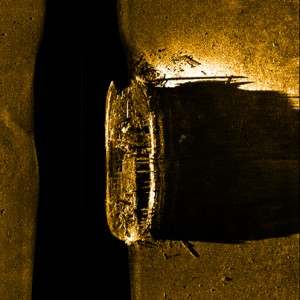Franklin Expedition find identified: HMS Erebus

Side-sonar scan image of one of the Franklin Expedition ships on the seafloor of the Queen Maud Gulf. (Photo courtesy of Parks Canada)
In case you missed it: Arctic researchers from the team searching for the lost Franklin Expedition have determined the identity of this summer’s big discovery: they have found the HMS Erebus.
Of course, the ship had to be either that or the HMS Terror. The Terror has an interesting connection to U.S. history, as one of the British ships that bombed Baltimore’s Fort McHenry, which inspired Francis Scott Key to write the Star Spangled Banner.
The Erebus may be the more exciting find from the British and Canadian perspective, for it was the flagship of the expedition’s commander, Sir John Franklin. (Indeed, there is some small speculation that Franklin’s body might possibly be aboard, as it is know he died before both ships became hopelessly trapped in ice.)
The importance and purpose of the Franklin Expedition is still subject to debate, but excitement over this find is keen, as seen by this quote from Ottawa Citizen coverage:
“Erebus was one of the great exploration ships of its era, of any era,” said John Geiger, CEO of the Royal Canadian Geographical Society. The society was a partner in the search.
“To find it in such an incredible state of preservation represents a great moment for Canada, for Britain, and for those throughout the world with an interest in geography and exploration,” he said in a statement.
“Franklin was based aboard Erebus, that ship is where he lived and likely where he died. It was at the very centre of this great historical mystery. The stunning condition of the ship and the artifacts represent a global treasure,” he said.
With apologies for the unbridled boosterism here’s a video featuring a number of the main leaders of this effort
The Citizen’s Tom Spears wrote several articles on the topic, including one making the case that Franklin brought an unusual degree of experience and relative expertise to exploring the Arctic. His ill-fated expedition set sail in 1845. But, to an unusual degree, Franklin had been there and done that, covering thousands of miles across places like the Mackenzie and Coppermise Rivers and costal waters in the 1820s. As Spears wrote:
He learned about overcoming hardship in the North. He learned to live off the land, and travel hundreds of kilometres on snowshoes. (They hurt his ankles.) Here’s a typical passage from when he was still in his mid-30s, an energetic and healthy leader as Ernest Shackleton was later:
“A supply of meat would have been very seasonable, as the men’s provision had become scanty, and the dogs were without food, except a little burnt leather. Owing to the scarcity of wood, we had to walk until a late hour, before a good spot for an encampment could be found, and had then attained only eleven miles. The night was miserably cold; our tea froze in the tin pots before we could drink it, and even a mixture of spirits and water became quite thick by congelation; yet, after we lay down to rest, we felt no inconvenience, and heeded not the wolves, though they were howling within view.”
For fans of wilderness, Arctic exploration, archeology, or history, it’s all just so much bounty! Read or see more at Parks Canada’s main page for the search.

Astern of the wreck, Parks Canada underwater archaeologist Filippo Ronca measures the muzzle bore diameter of one of two cannons found on the site, serving to identify this gun as a brass 6-pounder. Image: Thierry Boyer, Parks Canada






